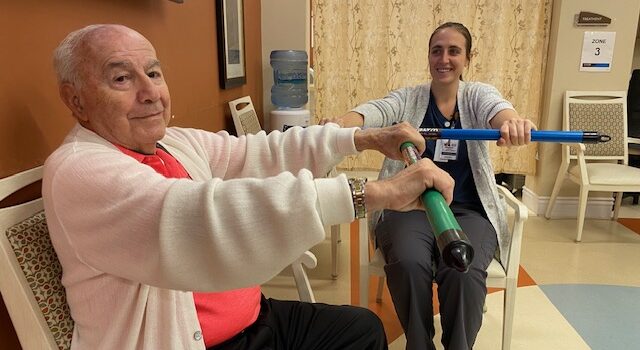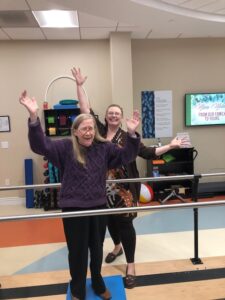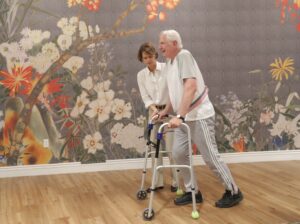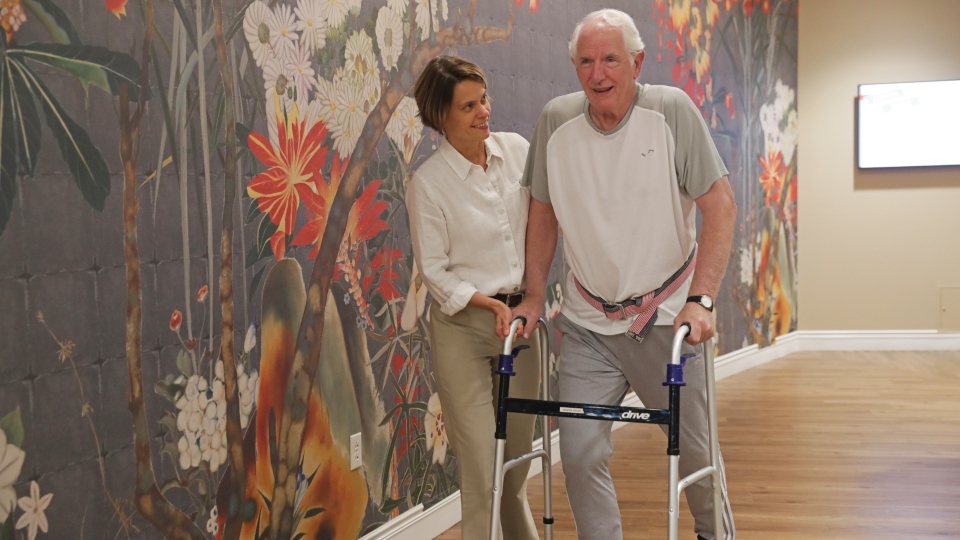At Branchlands Senior Living, we connect our residents to on-site preventive physical therapy because we understand its power to improve health and quality of life. (By the end of the article, you will, too!)
Our Independent Living, Assisted Living, and Memory Care residents are served by Powerback Rehabilitation. Located on-site at Branchlands, the highly skilled therapists work with residents on personalized programs which can include Physical Therapy (PT), Occupational Therapy (OT), and Speech-Language Therapy (ST). Our therapists emphasize preventive therapy because it’s the best way to increase resilience and better enjoy your golden years—and it saves lives.
Prevention Saves Lives and Increases Independence
As our bodies age, they tend to lose muscle mass, bone density, and balance reactions. These changes, along with any cognitive ones, can increase our anxieties and diminish our independence. As we feel less capable, we do less. As we do less, our capabilities decline further, creating a downward spiral.
Since 1 in 4 seniors fall each year in the U.S., falls are one of the most acute dangers. The changes mentioned above make falls both more likely and more severe.
Fortunately, most falls can be prevented, and loss of muscle, bone density, balance, and capability can be stopped or slowed through targeted therapy. With preventive therapy, we can recognize and correct issues before they cause problems.
Preventive Therapy is Easier and More Effective
When people think of physical therapy, they often think of recovery therapy: after an injury, illness, or other acute problem occurs, a patient sees a therapist to attempt to address new and significant issues. These might include pain, weakness, and other impediments.
Recovery therapy is immensely beneficial. Compared to preventive therapy, though, it’s a harder road. Once an acute problem occurs, you need to spend a lot more time and effort to build to a desired level of fitness and ability. There’s also the risk of an injury so severe that even with therapy you cannot get all the way back to your previous abilities.
In the long run, preventive physical therapy lets you avoid many problems and delay others. When you do encounter a bump in the road, you come to it with a higher level of skills, fitness, and confidence. That’s why we love it so much at Branchlands: it perfectly fits our philosophy of supporting residents’ independence and enriching their lives.
“By doing physical therapy with a preventive approach, you increase your fitness and your skills much more quickly. With faster progress, the experience is more positive and encouraging, making it easier mentally, as well as physically. As the proverb says, ‘an ounce of prevention is worth a pound of cure.”’ — Ashley Poe, Physical Therapist and Director of Rehab for Powerback Rehab of Charlottesville
PT, OT, and ST Offer Three Different Kinds of Preventive Therapy
We’ve been using “physical therapy” as a kind of umbrella term, but as we mentioned there are actually three distinct kinds of therapy performed at Branchlands, and all three provide serious long-term benefits.
Physical Therapy
In addition to cardiovascular health, physical therapy deals with gross motor capabilities: strength, balance, and flexibility. It involves the whole body, but often focuses especially on the core and the lower body. For older adults, physical therapy tends to focus on supporting mobility: our ability to get up and down, to walk, to exercise at the appropriate level—and to do it all safely.
Occupational Therapy
Occupational therapy works on fine-motor control, though it also addresses issues such as upper extremity range of motion. OT improves our ability to perform the very specific tasks we do each day, from eating and bathing and using the restroom, to using a toothbrush, TV remote, or smartphone.
Speech-Language Therapy
In addition to dealing with speech (aphasia, vocal quality, intelligibility) and swallowing, speech-language therapy can address memory and cognitive communication. For memory care patients, and any of us who might be experiencing or expecting mild cognitive decline, it provides a way to reduce frustrations and improve communication.
Preventive speech-language therapy can also be a matter of preparation. At later stages of cognitive decline, we might not be able to learn new skills. By practicing a skill in advance, such as using a mobility device, and making it a part of muscle memory, we equip ourselves for staying mobile and capable even in the event of significant cognitive decline.
Adaption Plays a Key Role in Prevention
If you have trouble getting out of bed, one of the first things the Powerback therapists will do is adapt your bedroom. Rather than have you continue to try and fail to get out of bed the way you used to, the therapists will add a bed cane.
Likewise, if you find it difficult to get on and off the toilet, they’ll help you set up a raised seat.
Good adaptations let us keep being independent and capable. They prevent frustrations and falls while we work on addressing underlying issues of strength or flexibility, making the therapy process quicker and easier.
Adaptation often comes down to getting the right tools and practicing using them. Shoehorns, button hooks, shower benches, and weighted utensils are all examples of OT adaptations which we use at Branchlands to increase or maintain independence and activity.
ST also makes use of adaptive tools to help with organization. A resident might come to the therapist with a concern such as, “I miss so many activities.” In this case, the therapist will work with them to create a calendar and set alarms. A smart speaker like Amazon’s Alexa can also be used to provide vocal reminders: It’s time to use the restroom, or It’s time to go to lunch. The key goal is to allow the resident to be more functional within their current situation.
Screenings and Logistical Support Make Preventive Therapy Accessible
“As soon as a resident moves in, we offer a move-in screen. We use evidence-based, standardized tests to immediately let them know if they are, for example, at risk for a fall, an injury, or cognitive decline.” — Ashley Poe, Director of Rehab
By using an introductory screening, the therapists at Branchlands identify any issues which might benefit immediately from therapy, and they establish a baseline to compare against future quarterly and yearly screenings.
The landscape of our healthcare system often makes it easier to get insurance to cover treatment for existing problems than for prevention. However, when a screening turns up early warning signs for an issue down the road, it provides the basis for beginning the therapy process. The use of regular screenings—residents can receive screenings any time they wish and will receive quarterly screenings at a minimum—allow for therapy to be used in a more preventive, rather than reactive, way.
Ashley Poe, the Director of Rehab, stresses that Powerback’s therapists are there to help. She knows it can be a hassle to work with doctors and get through all the logistical hurdles and paperwork. If you have an issue, she says, you can simply call or stop by. Powerback can then call your physician(s), get the necessary approvals, and help complete the paperwork, so that you can focus on your health.
“All you have to do is call, and I can handle the rest of it for you.” — Ashley Poe, Director of Rehab
Preventive Physical Therapy Should Take Place Inside and Outside the Gym
When you walk into the gym in Linden House, you’ll see all the equipment you’d find in a typical rehabilitation center: from NuStep exercise machines, parallel bars, weights, and surface mats to the devices used for electrical stimulation and ultrasound therapy.
In many ways, though, the most important thing to understand about rehab at Branchlands is that it doesn’t only happen in this room. The goal of all therapy is to improve your capacity to live your life to the fullest, and you don’t live your life in a gym. For this reason, therapy at Branchlands often takes place where you do live it.
If you want to navigate your home and community areas more safely, a therapist can work with you in those spaces. If your challenge is being able to order dinner at a restaurant, a speech-language therapist will come with you on your next outing to work with you on that. On-site therapists who are embedded in the Branchlands community provide incredible benefits that you simply could not get from visiting an off-site rehab center.
“Since we are inside assisted living, a huge part of what we do is not only to exercise but to improve and practice daily functions. We work with residents in their rooms, with their furniture, their beds. We can go with them to community events and outings. We don’t just work in the gym. The whole community is where we practice.” — Ashley Poe, Director of Rehab
An Embedded, Top-Notch Provider Makes the Difference at Branchlands
The therapists at Powerback Rehab of Charlottesville have deep expertise in their fields. For decades they’ve been working with seniors to maintain the best possible health in the face of the many issues that arise as we age. Through regular screenings, the latest best-practices, and the insights and access that come from their placement within the community, they provide the highest level of therapeutic care.
“Our clinic regularly scores over 81.8 average on Mindfulness-Based Interventions (MBIs), has an effectiveness of 40.8% (the overall effectiveness average of other sites is 26.5%), and has a length of treatment around 12 days shorter than the average,” says Poe. “Essentially we are getting people to participate here at Linden House better than most clinics and faster than most clinics!”
It’s all part of our commitment at Branchlands Senior Living to the health, happiness, and independence of all our residents.
Want to learn more about physical therapy at Branchlands or about life in our community? Contact us today.






